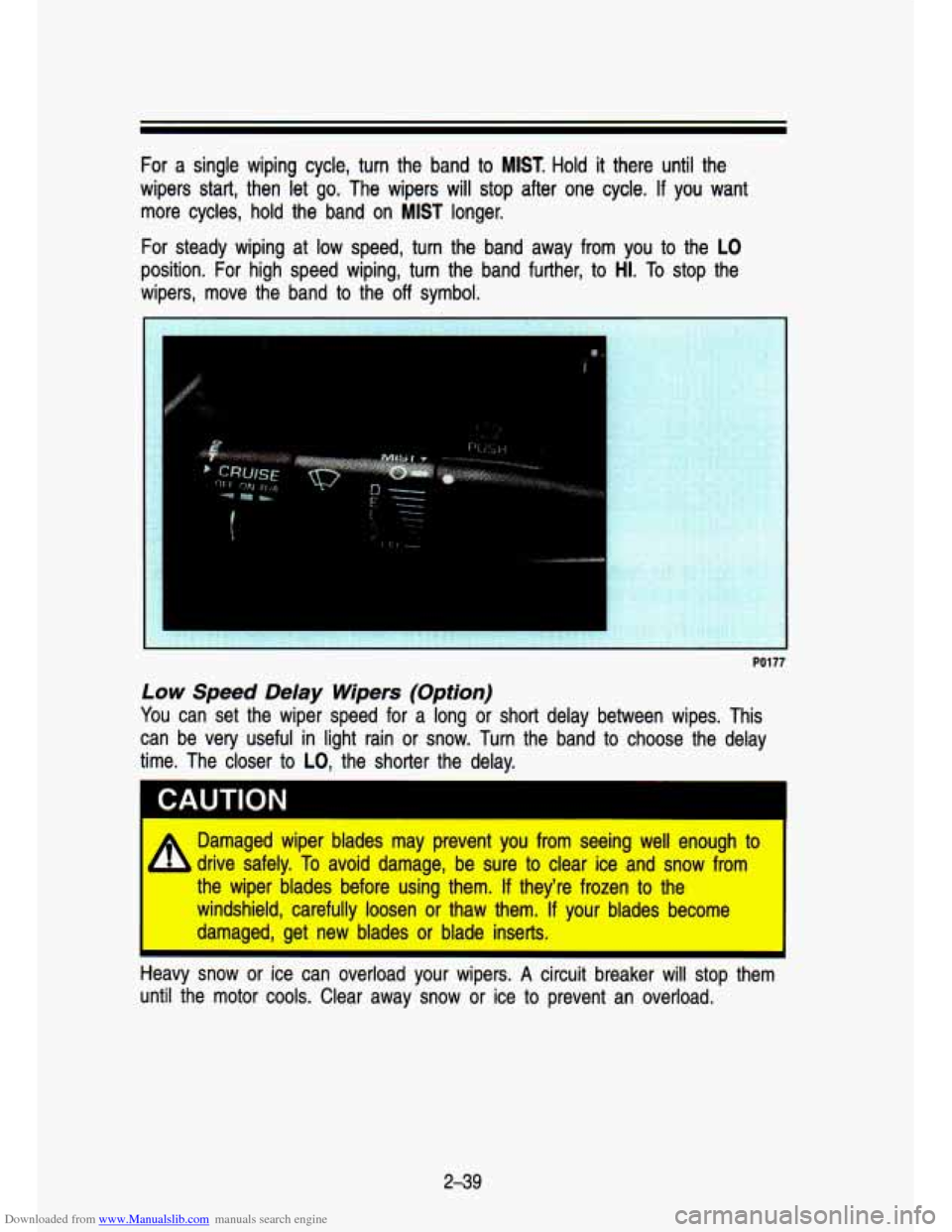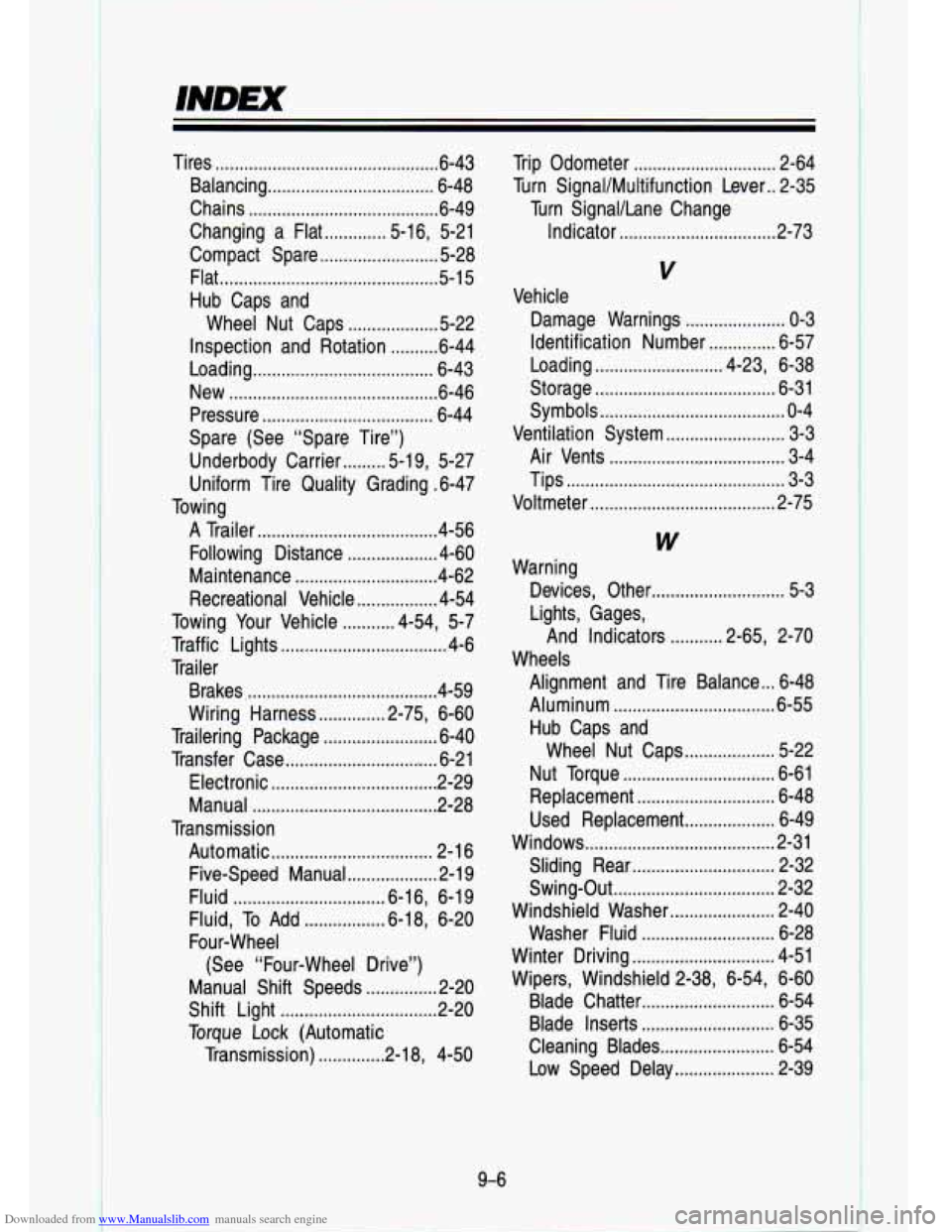1993 CHEVROLET S10 wiper blades
[x] Cancel search: wiper bladesPage 91 of 356

Downloaded from www.Manualslib.com manuals search engine For a single wiping cycle, turn the band to MIST. Hold it there until the
wipers start, then let
go. The wipers will stop after one cycle. If you want
more cycles, hold the band on
MIST longer.
For steady wiping at
low speed, turn the band away from you to the LO
position. For high speed wiping, turn the band further, to HI. To stop the
wipers, move the band to the
off symbol.
PO177
Low Speed Delay Wipers (Option)
You can set the wiper speed for a long or short delay between wipes. This
can be very useful in light rain or snow. Turn the band to choose the delay
time. The closer to
LO, the shorter the delay.
Damaged wiper blades may prevent
you from seeing well enough to I
drive safely. To avoild damage, ble sure to &air ice and SKIW from
the wiper blades before usilng them.
If they're frozen to the
wi'ndshield, carefully
lloosen or thaw them. If your blades become
damaged, get new blades
or blade inlserts. I
I leavy snow or ice can overload your wipers. A circuit breaker will stop them
until the motor cools. Clear away snow or ice
to prevent an overload.
2-39
Page 191 of 356

Downloaded from www.Manualslib.com manuals search engine Driving in &ye Rain
I
AM455004
Rain and wet roads can mean driving trouble. On a wet road y\
ou can’t stop,
accelerate or turn as well because your tire-to-road traction isn’t as good as
on dry roads. And,
if your tires don’t have much tread left, you’ll get even
less traction.
It’s always wise to go slower and be cautious
if rain starts to fall while you
are driving. The surface may get wet suddenly when your reflexes are tuned
for driving on dry pavement.
The heavier the rain, the harder it is to see. Even
if your windshield wiper
blades are in good shape, a heavy rain can make it harder to see road signs
and traffic signals, pavement markings, the edge of the road, and even
people walking. Road spray can often be worse for vision than rain,
especially
if it comes from a dirty road.
So it is wise to keep your wiping equipment in good shape and keep your
windshield washer tank filled. Replace your windshield wiper ins\
erts when they show signs of streaking or missing areas on the windshield, or when strips of
rubber start to separate from the inserts.
4-37
Page 198 of 356

Downloaded from www.Manualslib.com manuals search engine Your Driving and the Road
..
C. .-, - ._ .
may tend to think you are going slower than you actually are.\
For example,
40 mph (65 km/h) might seem like only 20 mph (30 km/h). Obviously, this
could lead to serious trouble on a ramp designed for
20 mph (30 km/h)!
Driving a Long Distance
Although most long trips today are made on freeways, there are\
still many
made on regular highways.
Long-distance driving on freeways and regular highways is the s\
ame in some
ways. The trip has to be planned and the vehicle prepared, yo\
u drive at
higher-than-city speeds, and there are longer turns behind the \
wheel. You’ll
enjoy your trip more if you and your vehicle are in good shape. Here are
some tips for a successful long trip.
Before Leaving on a Long Trip
Make sure you’re ready. Try to be well rested. If you must start when you’re
not fresh-such as after a day’s work-don’t plan to make too many miles
that first part of the journey. Wear comfortable clothing and shoes you can
easily drive in.
Is your vehicle ready for a long trip? If you keep it serviced and maintained,
it’s ready to go.
If it needs service, have it done before starting out. Of
course, you’ll find experienced and able service experts in \
your vehicle’s
dealerships all across North America. They’ll be ready and w\
illing to help
if
YOU
Her1
0
need it.
ire
Some things you can check before a trip:
Windshield Washer Fluid:
Is the reservoir full? Are all windows clean
inside and outside?
Wiper Blades: Are they in good shape?
Fuel, Engine Oil, Other Fluids: Have you checked all levels?
Lights: Are they all working? Are the lenses clean?
Tires: They are vitally important to a safe, trouble-free trip.\
Is the tread
good enough for long-distance driving? Are the tires all inflat\
ed to the
recommended pressure?
Weather Forecasts: What’s the weather outlook along your rout\
e? Should you delay your trip
a short time to avoid a major storm system?
Maps:
Do you have up-to-date maps?
4-44
Page 302 of 356

Downloaded from www.Manualslib.com manuals search engine Service & Appearance Cave
Cleaning the Outside of Your Windshield and Wiper Blades
If the windshield is not clear after using the windshield washer, or if the wiper
blade chatters when running, wax or other material may be on the blade or
windshield.
Clean the outside of the windshield with GM Windshield Cleaner, Bon-Ami
Powder@ (GM Part
No. 1050011). The windshield is clean if beads do not
form when you rinse it with water.
Clean the blade by wiping vigorously with a cloth soaked in full strength
windshield washer solvent. Then rinse the blade with water.
Wiper blades should be checked on a regular basis and replaced\
when worn.
Cleaning the Outside of Your Vehicle
The paint finish on your vehicle provides beauty, depth of color, gloss
retention and durability.
Washing Your Vehicle
The best way to preserve your vehicle’s finish is to keep it clean by washing
it often with lukewarm or cold water.
Don’t wash your vehicle in the direct rays of the sun. Don’t use strong soaps
or chemical detergents. Use liquid hand or dish or car washing\
(non-detergent) soaps. Don’t use cleaning agents that contai\
n acid or
abrasives. All cleaning agents should be flushed promptly and n\
ot allowed
to
dry on the surface, or they could stain. Dry the finish with \
a soft, clean
chamois or
100% cotton towel to avoid surface scratches and water spotting.
High pressure car washes may cause water
to enter your vehicle.
Finish Care
Occasional waxing or mild polishing of your vehicle may be necessary to
remove residue from the paint finish. You can get GM approved \
cleaning
products from your dealer. (See “Appearance Care and Materia\
ls’’ in the Index.)
Protecting Exterior Bright Metal Parts
Bright metal parts should be cleaned regularly to keep their luster. Washing
with water is all that is usually needed. However, you may us\
e GM Chrome
Polish on chrome or stainless steel trim,
if necessary.
Use special care with aluminum trim.
To avoid damaging protective trim, never
use auto or chrome polish, steam or caustic soap to clean aluminum.
A
coating of wax, rubbed to a high polish, is recommended for all bright metal
parts.
6-54
Page 352 of 356

Downloaded from www.Manualslib.com manuals search engine ... .. .- i’. .. - . .
Tires ............................................... 6.43
Balancing
................................... 6-48
Chains
........................................ 6-49
Changing a Flat
............. 5.16, 5-21
Compact Spare
......................... 5-28
Flat
.............................................. 5-1 5
Hub Caps and Wheel Nut Caps
................... 5-22
Inspection and Rotation
.......... 6-44
Loading
...................................... 6-43
New
............................................ 6-46
Pressure
..................................... 6-44
Spare (See “Spare Tire”)
Uniform Tire Quality Grading
. 6-47
A Trailer
...................................... 4-56
Following Distance
................... 4-60
Maintenance
.............................. 4-62
Recreational Vehicle
................. 4-54
Towing Your Vehicle
........... 4-54, 5-7
Traffic Lights
................................... 4-6
Trailer
Brakes
......................................... 4-59
Wiring Harness
.............. 2-75, 6-60
Trailering Package
........................ 6-40
Transfer Case
................................. 6-21
Electronic
................................... 2-29
Manual
....................................... 2-28
Automatic
.................................. 2-1 6
Five-Speed Manual
................... 2-1 9
Fluid
................................ 6-1 6, 6-1 9
Fluid, To Add
................. 6-18, 6-20
Four-wheel
Manual Shift Speeds
............... 2-20
Shift Light
................................. 2-20
Torque Lock (Automatic
Transmission)
.............. 2-1 8, 4-50
Underbody
Carrier
......... 5-1 9, 5-27
Towing
Transmission (See “Four-wheel Drive”) Trip
Odometer
.............................. 2-64
Turn Signal/Multifunction Lever
.. 2-35
Indicator
................................. 2.73
Turn SignaVLane Change
V
Vehicle
Damage Warnings
..................... 0-3
Identification Number
.............. 6-57
Loading
........................... 4.23. 6-38
Storage
...................................... 6-31
Symbols
....................................... 0-4
Ventilation System
......................... 3-3
Air Vents
...................................... 3-4
Tips
.............................................. 3-3
Voltmeter ....................................... 2-75
I
W
Devices. Other ............................ 5-3
Lights. Gages. And Indicators
........... 2.65. 2-70
Alignment and Tire Balance
... 6-48
Aluminum
.................................. 6-55
Hub Caps and Wheel Nut Caps
................... 5-22
Nut Torque
................................ 6-61
Replacement
............................. 6-48
Used Replacement
................... 6-49
Windows
........................................ 2-31
Sliding Rear
.............................. 2-32
Swing-Out
.................................. 2-32
Windshield Washer
...................... 2-40
Washer Fluid
............................ 6-28
Winter Driving
.............................. 4-51
Wipers. Windshield 2.38. 6.54. 6-60
Blade Chatter
............................ 6-54
Blade Inserts
....... .................... 6-35
Cleaning Blades
........................ 6-54
Low Speed Delay
..................... 2-39
Warning
Wheels
9-6